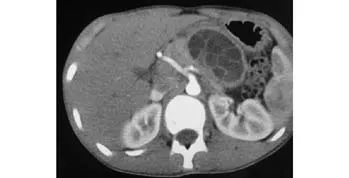Primary pancreatic hydatid disease associated with acute pancreatitis
2010-04-07TotheEditor
To the Editor:
Primary pancreatic hydatid disease associated with acute pancreatitis
To the Editor:
Hydatid disease is still endemic in the Middle East as well as in Turkey. Although the liver and lungs are the most frequently involved, other organs may also be affected.[1-3]Isolated involvement of the pancreas is unusual, and acute pancreatitis secondary to hydatid cyst has rarely been reported. To our knowledge, 4 cases have been reported in the literature.[4]Here we report a new case of acute pancreatitis due to primary pancreatic hydatid disease.
An 18-year-old man was admitted to our clinic with complaints of abdominal and back pain, nausea,vomiting, and fever for 15 days. His past medical history was unremarkable. On physical examination, vital signs were normal other than a temperature of 38.5 ℃. He had tenderness in the right abdominal quadrant while examination of other systems was normal. Laboratory analyses were as follows: white blood count 24 500/mm3;hemoglobin 13.8 g/dl; platelets 159 000/mm3; amylase 1540 U/L (17-115); alanine aminotransferase (ALT) 221 U/L (0-40); aspartate transaminase (AST) 63 U/L (0-40);alkaline phosphatase (ALP) 280 U/L (38-155); gammaglutamyl transpeptidase (GGT) 217 U/L (15-60); total bilirubin 0.45 mg/dl (0.1-2.0); direct bilirubin 0.3 mg/dl(0.1-0.8); albumin 3.6 g/dl; C-reactive protein 9.1 mg/L(0-5); and erythrocyte sedimentation rate 40 mm/h.Serological tests for Entamoeba (hemagglutination test),HBsAg, anti-HBc IgM, anti-HCV, and anti-HIV were negative. Lung radiography and hepatic ultrasound were normal. Abdominal computed tomography and magnetic resonance imaging revealed a multi-loculated 45×70 mm cystic lesion in the corpus of the pancreas, a dilated pancreatic duct behind the cyst, and an enlargement of the body of the pancreas (Fig.). Nothing was detected in the liver or in any other organs. After albendazole 800 mg/day was initiated, the patient underwent surgery for primary pancreatic hydatid disease. Cystectomy and distal pancreatectomy were performed. Sixty milliliter of cystic fl uid was removed by a injector and a scolytic agent was injected into the cyst. The scolex membrane was aspirated and a drainage catheter was inserted. Histopathological examination revealed a hydatid cyst in the corpus of the pancreas. Twenty days later, localized fl uid was observed in the region of operation by abdominal ultrasonography.An ultrasonography-guided external drainage catheter was used to drain 600-700 ml liquid with a high amylase level. With suspicion of pancreatic duct injury, endoscopic retrograde cholangiopancreatography (ERCP) was performed and a pancreatic stent was placed. Shortly after ERCP, drainage from the external catheter ended and the drain was disconnected a week later. Four months later in the follow-up period the patient was doing well and was advised to return for a stent exchange.
Cystic echinococcosis is a widespread chronic endemic helminthic disease caused by metacestodes of the tapeworm Echinococcus granulosus. The vast majority of patients have single-organ involvement, and more than two thirds have only one cyst. Isolated pancreatic disease is rare and it is estimated to have a prevalence of 0.14% to 2%.[2]The mode of infestation is hematogenous, via the pancreatic or bile duct as well as the lymphatic pathway.The cyst in the pancreas is localized in the head (57%),corpus (24%) or tail (19%) of the pancreas. Clinical presentation varies according to the anatomic location of the cyst. Abdominal pain, abdominal discomfort, and vomiting are the most common clinical symptoms. The patient may present with obstructive jaundice, weight loss,an epigastric mass, and/or recurrent acute pancreatitis which may resemble a pancreatic cystic neoplasm.[3,4]Although cystotomy and drainage are the preferred treatment methods, total cystectomy is another choice if the localization of the cyst in the pancreas is appropriate for surgery. In the literature, there are cases successfully treated with distal pancreatectomy in which hydatid cysts were localized in the tail of the pancreas.[5]The longterm outcome is variable and many patients remain asymptomatic. However, percutaneous drainage may also be the choice for selected cases. Surgical or endoscopic stent replacement into the pancreatic channel is necessary if there is a connection between the cyst and the pancreatic duct. To date, there are 4 reported cases of acute pancreatitis secondary to hydatid cyst.[4,6-8]Ours was a rare case of hydatid disease causing acute pancreatitis which was localized in the pancreas and successfully treated with the combination of surgery and endoscopy.

Fig. Computed tomography showing a hydatid cyst of the pancreas.
In conclusion, pancreatic hydatidosis should be considered in the differential diagnosis of pancreatic cystic lesions associated with acute pancreatitis. Surgical,percutaneous, or endoscopic approaches alone or in combination are the therapeutic options. Medical treatment with albendazole may be preferred as chemoprophylaxis before and after drainage.JOP 2007;8:232-234.
6 Sebbag H, Partensky C, Roche J, Ponchon T, Martins A.Recurrent acute pancreatitis from the rupture of a solitary pancreatic hydatid cyst into Wirsung's canal. Gastroenterol Clin Biol 1999;23:793-794.
7 Augustin N, Gamstatter G, Neher M, Schreyer T, Storkel S.Echinococcus cysticus of the pancreas in the clinical picture of acute pancreatitis. Chirurg 1984;55:661-664.
8 Katkhouda N, Legoff D, Tricarico A, Castillo L, Bertrandy M,Mouiel J. Hydatid cyst of the pancreas responsible for chronic recurrent pancreatitis. Presse Med 1988;17:2021-2023.
Karakaş E
Department of Radiology
Şanlıurfa Education and Research Hospital
Şanlıurfa, Turkey
Tuna Y
Department of Gastroenterology
Akdeniz University Faculty of Medicine
Antalya, Turkey
Başar Ö
Department of Gastroenterology
Dışkapı Education and Research Hospital
Ankara, Turkey
Köklü S
Department of Gastroenterology
Ankara Education and Research Hospital Ankara, Turkey
(Email: gskoklu@yahoo.com)
1 Ozekinci S, Bakir S, Mizrak B. Evaluation of cystic echinococcosis cases given a histopathologic diagnosis from 2002 to 2007 in Diyarbakir. Turkiye Parazitol Derg 2009;33:232-235.
2 Ibis C, Albayrak D, Altan A. Primary hydatid disease of pancreas mimicking cystic neoplasm. South Med J 2009;102:529-530.
3 Sa fi oleas MC, Moulakakis KG, Manti C, Kostakis A. Clinical considerations of primary hydatid disease of the pancreas.Pancreatology 2005;5:457-461.
4 Ozmen MM, Moran M, Karakahya M, Coskun F. Recurrent acute pancreatitis due to a hydatid cyst of the pancreatic head:a case report and review of the literature. JOP 2005;6:354-358.
5 Moosavi SR, Kermany HK. Epigastric mass due to a hydatid cyst of the pancreas. A case report and review of the literature.
杂志排行
Hepatobiliary & Pancreatic Diseases International的其它文章
- Pancreatic duct stones in patients with chronic pancreatitis: surgical outcomes
- Methylprednisolone inhibits activated CD4+ T cell survival promoted by toll-like receptor ligands
- Endoscopic management of postcholecystectomy biliary leakage
- Magnetic resonance imaging-guided percutaneous cryoablation of hepatocellular carcinoma in special regions
- Radiofrequency ablation, heat shock protein 70 and potential anti-tumor immunity in hepatic and pancreatic cancers: a minireview
- Endoscopic retrograde cholangiopancreatography outcome from a single referral center in Iran
